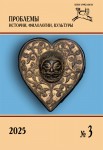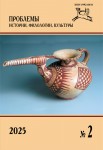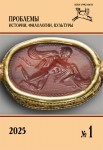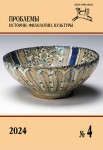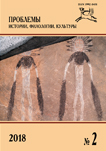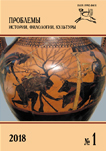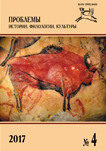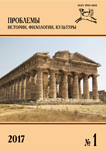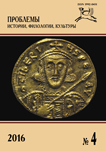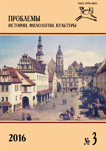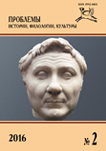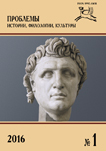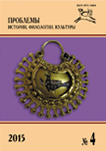Аннотация
В статье предпринята попытка воссоздать основные направления и стимулы эволюции социальной организации Афин, которые привели к возникновению полиса. Микенская катастрофа вызвала не только запустение Аттики, но и длительную концентрацию населения в Афинах. Это, на наш взгляд, наложило отпечаток на процесс возникновения и эволюции социальных институтов. В работе поддерживается ранее высказанное предположение, что афинские (ионийские) филы существовали уже в Микенский период. В процессе последующей ионийской миграции они получили распространение и в малоазийских (ионийских) полисах. Трудно сказать, существовали ли фратрии в микенский период, однако можно предположить, что они возникли или начали складываться в период миграций. Примерно с IX в. до н.э. (Геометрический период) начинается процесс, называемый нередко внутренней колонизацией. В его ходе население, прежде сконцентрированное в Афинах, начинает заселять Аттику. Итогом этого процесса становится децентрализация формирующегося государства (полиса) или разрыв связей центра и периферии. Естественно, это создает стимул для восстановления (или обретения) единства. Это происходит в результате того, что мы называем синойкизмом Тезея. Итогом становится формирование архаического (аристократического) полиса.
Хотя хронологически рассматриваемые нами проблемы укладываются в промежуток между XI и VIII вв. до н.э., в заголовок работы выносится упоминание о синойкизме Тезея – событии, вне всякого сомнения, легендарном. Отдавая себе отчет в этом, мы, тем не менее, полагаем, что формирование афинского полиса стало результатом того, что хотя бы условно можно назвать синойкизмом Тезея.
Ключевые слова
Древняя Греция, Афины, Постмикенский регресс, депопуляция, период Темных веков, ионийские филы, фратрии, синойкизм, Тезей.
Андреев, Ю.В.1985: К проблеме постмикенского регресса. ВДИ 3, 9-29.
Андреев, Ю.В. 2002: От Евразии к Европе. Крит и Эгейский мир в эпоху бронзы и раннего железа (III – начало I тыс. до н.э.). СПб.
Блаватская, Т.В.2003: Черты истории государственности Эллады. СПб.
Лециус, И.А. 1905: Заметки об аттических филах. Известия Киевского университета 12, 1–15.
Лаптева, М.Ю. 2009: У истоков греческой цивилизации. Иония XI–VI вв. до н.э. СПб.
Рунг, Э.В., Венидиктова, Е.А. 2010: Синойкизм и возникновение демократии в Аргосе. ВДИ 1 (272), 13–30.
Суриков, И.Е.2013: Афины в VIII-VII вв. до н.э.: становление архаического полиса (к вопросу о степени специфичности «аттического варианта». ВДИ 4 (287), 23–43.
Фролов, Э.Д. 2004: Рождение греческого полиса. СПб. (2-е изд.).
Хаммонд, Н. 2003: История Древней Греции. М.
Яйленко, В.П.1990: Архаическая Греция и Ближний Восток. М.
Alexandridou, A. 2017: Some insights into the Early Attic Society (10th – 7th Century B.C.). In: A. Mazarakis Ainian, A. Alexandridou and X. Charalambidou (eds.), Regional Stories. Towards a New Perception of the Early Greek World. Volos, 155–176.
Anderson, G. 2003: The Athenian Experiment. Building an imagined Political Community in Ancient Attica, 508–490 B.C. Ann Arbor.
Bintliff, J. 2012: The Complete Archaeology of Greece. From Hunter-Gatherers to the 20 Century A.D. Wiley–Blackwell.
Broneer, O. 1948: What happened at Athens. AJA 52, 111–114.
Camp, J.M. 1985: The Athenian Agora. Excavations in the Heart of Classical Athens. London.
Cavanagh, W. 2009: Settlement Structure in Laconia and Attica at the End of the Archaic Period: The Fractal Dimension. AJA 113, 405–421.
Coldstream, J.N. 1976: Hero Cults in the Age of Homer. JHS 96, 8–17.
Coldstream J.N. 1977: Geometric Greece. London.
Coldstream, J.N. 1994: Warriors, chariots, dogs and lions: a new Attic Geometric Amphora. BICS 39, 85–94.
Connor, W.R. 1993: The Ionian Era of Athenian Civic Identity. Proceedings of the American Philosophical Society 137, 194–206.
Cook, J.M.1975: Greek Settlement in the Eastern Aegean and Asia Minor. In: I.E.S. Edwards, C.J. Gadd, N.G.L. Hammond, E. Sollinger (eds.), The Cambridge Ancient History. Vol. 2. Pt. 2, Cambridge, 773–804.
Crielaard, J.P.2009: The Ionians in the Archaic Period. Shifting identities in a changing world. In: T. Derks, N. Roymans (eds.), Ethnic Constructs in Antiquity. The Role of Power and Tradition. Amsterdam, 37–84.
Demetriadou, E. 2017: The Development of Early Athens from ca. 1125 B.C. to the End of the 8th Century B.C. In: J.K. Papadopoulos, E. Lord Smithson. The Athenian Agora 36. The Early Iron Age. The Cemeteries. Princeton, 985–989.
Desborough, V.R.d’A. 1972: The Greek Dark Ages. London.
Donlan, W. 1985: The Social Groups of Dark Age Greece. Classical Philology 80, 293–308.
Engelmann, H. 1996: Phylen und Chyliastyen von Ephesos, ZPE 113, 94–100.
Ferguson, W.S.1936: The Athenian Law Code and the Old Attic Trittyes. In: Classical Studies Presented to E. Capps. Princeton, 144–158.
Greaves, A.M. 2010. The Land of Ionia. Society and Economy in the Archaic Period. Wiley- Blackwell.
Hall, J.M.1997: Ethnic Identity in Greek Antiquity. Cambridge.
Hall, J.M.2014: A History of the Archaic Greek World. Ca 1200–479 BCE. Wiley-Blackwell.
Hedrick, C.W. 1991: Phratry Shrines of Attica and Athens, Hesperia 60, 241–268.
Hignett, C. 1952: A History of the Athenian Constitution to the end of the 5th Century B.C. Oxford.
Hornblower, S, 1991: A Commentary on Thucydides. Vol. 1. Oxford.
Humphreys, S.C. 2018: Kinship in Ancient Athens. An Anthropological Analysis. Vol. 1–2. Oxford.
Huxley, G.L. 1966: The Early Ionians. London.
Jones, N.F.1999: The Associations of Classical Athens. Response to Democracy. Oxford.
Lambert, S.D. 1993: The Phratries of Attica. Ann Arbor.
Lang, F. 2007: House-community-settlement: the new concept of living in Archaic Greece. Building Communities. House, Settlement and Society in the Aegean and Beyond. British School of Athens. Studies 15, 183–193.
Meritt, B.D. 1935: Inscriptions of Colophon. AJPh 56, 358–397.
Moggi, M.1976: I sinecismi interstatali greci. Vol.1. Dalle origini al 338 a.C. Pisa.
Morris, I. 1987: Burial and Ancient Society. The rise of the Greek city-state. Cambridge.
Morris, I. 1998: Archaeology and Archaic Greek History. In: N. Fisher, H. van Wees (eds.), Archaic Greece. New Approaches and New Evidence. London, 1–91.
Morris, I. 2009: The Eight-century Revolution. In: K.A. Raafl aub, H. van Wees (eds.), Companion to Archaic Greece. Wiley–Blackwell, 64-80.
Ober, J. 1989: Mass and Elite in Democratic Athens. Princeton.
Osborne, R.1985: Demos. The Discovery of Classical Attika. Cambridge.
Osborne, R.1987: Classical Landscape with Figures. The Ancient Greek City and its Countryside. London.
Osborne, R. 2009: Greece in the Making. 1200-479 BC. London.
Papadopoulos, J.K. and Smithson, E.L. 2017: The Athenian Agora 36. The Early Iron Age. The Cemeteries. Princeton.
Parke, H.W.1977: Festivals of the Athenians. London.
Polignac, de F.1995: Cults, Territory and the Origins of the Greek City-State. Chicago.
Rhodes, P.J. 1993: A Commentary on the Aristotelian Athenaion Politeia. Oxford.
Robertson, N. 1992: Festivals and Legends. Toronto.
Roebuck, C.1959: Ionian Trade and Colonization. New York.
Roebuck, C. 1961: Tribal Organization in Ionia. TAPA 92, 495–507.
Roebuck, C. 1972: Some Aspects of Urbanization in Corinth. Hesperia 41, 96–127.
Roussel, D. 1976: Tribu et Cité. Études sur les groups sociaux dans les cités grecques aux époques archaïque et classique. Besançon.
Rousset, D. 2014: La stele des Géléontes au sanctuaire de Claros. La souscription et les acquisitions immobilières d’un subdivision civique de Colophon. Journal des Savants 1, 3–98.
Sakellariou, M.B. 1958: La Migration grecque en Ionie. Athènes.
Sealey, R.1960: Regionalism in Archaic Athens. Historia 9, 155–180.
Sealey, R. 1976: A History of the Greek City-States.700–338 B.C. Berkeley– Los Angeles.
Snodgrass, A.M.1971: The Dark Age of Greece. An Archaeological survey of the eleven to the eighth centuries B.C. Edinburgh.
Snodgrass, A.M. 1980: Archaic Greece. The Age of Experiment. Berkeley and Los Angeles.
Snodgrass, A.M. 1982: Les origins du Cult de héros dans la Grèce antique. In: G. Gnoli, J.- P. Vernant (eds), La mort, les morts dans les societies anciennes. Cambridge, 107–119.
Snodgrass, A.M.1983: The Early Iron Age: a reappraisal. DHA 9, 73–86.
Snodgrass, A.M.1991: Archaeology and the study of the Greek city. In: J. Rich, A. Wallace- Hadrill (eds.), City and Country in the Ancient World. London, 1–24.
Tsetskhladze, G.R. 2006: Revisiting Ancient Greek Colonization. In: G.R. Tsetskhladze (ed.), Greek Colonization. An Account of Greek Colonies and Other Settlements Overseas 1. Leiden–Boston, XXIII–LXXXIII.
Van Gelder, K. 1991: The Iron-Age Hiatus in Attica and the “Synoikismos” of Theseus. Mediterranean Archaeology 4, 55–64.
Vanschoonwinkel, J.2006: Greek Migrations to Aegean Anatolia in the Early Dark Age. In: G.R. Tsetskhladze (ed.), Greek Colonization. An Account of Greek Colonies and Other Settlements Overseas 1. Leiden–Boston, 115–141.
Whitley, J.1988: Early States and Hero Cults: A Re-Apparisal. JHS 108, 173–182.
Whitley, J.1991a: Style and Society in Dark Age Greece. Cambridge.
Whitley, J.1991b: Social Diversity in Dark Age Greece. ABSA 86, 341–365.




